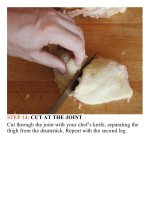The food lab better home cooking through science ( PDFDrive ) 769
Bạn đang xem bản rút gọn của tài liệu. Xem và tải ngay bản đầy đủ của tài liệu tại đây (182.52 KB, 2 trang )
BONES
Q:Here’soneforyou:bone-inorbone-out?
I’ve always wondered about this one myself, so I ran a
series of tests. Many chefs say that cooking meat on the
bone is always a better idea because the bone contributes
lotsofflavor.I’mskeptical.Firstofall,mostoftheflavorin
a bone is deep inside, in the marrow. If you ever make a
stock out of just bones, you’ll find that it’s almost tasteless
unless the bones are cracked first. And as far as flavor
penetration goes, there’s very little movement of molecules
acrossapieceofmeat.Evenmarinatingovernightwillonly
getyouacouplemillimetersofpenetration(moreonthatin
a moment). What chance does any flavor from the bone
have of getting into the meat during the short roasting or
pan-searingtime?
To test this, I cooked four identical prime rib roasts.The
first was cooked with the bone on. For the second, I
removedthebonebutthentieditbackagainstthemeatfor
cooking.Forthethird,Iremovedtheboneandtieditback
against the meat, but with an intervening piece of
impermeable heavy-duty aluminum foil. The fourth was
cookedwithoutthebone.
Tasted side by side, the first three were indistinguishable
fromoneanother.Thefourth,ontheotherhand,wasalittle
tougher in the region next to where the bone used to be.
What does this indicate?Well, first off, it means the flavor
exchange theory is bunk—the completely intact piece of
meattastedexactlythesameastheonewiththeintervening
aluminumfoil.Butitalsomeansthattheboneservesatleast
one important function: it insulates the meat, slowing its
cookingandprovidinglesssurfaceareatolosemoisture.









